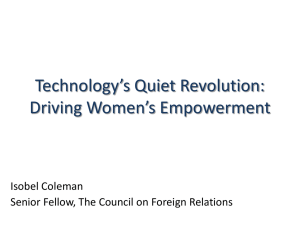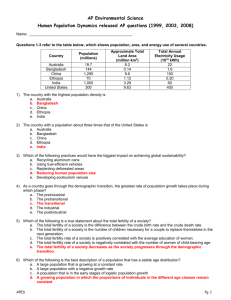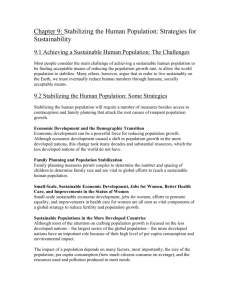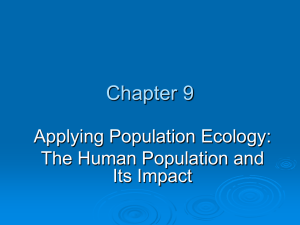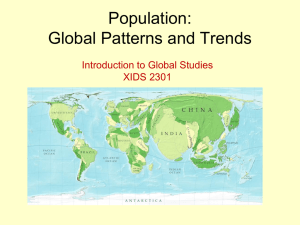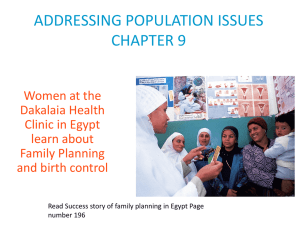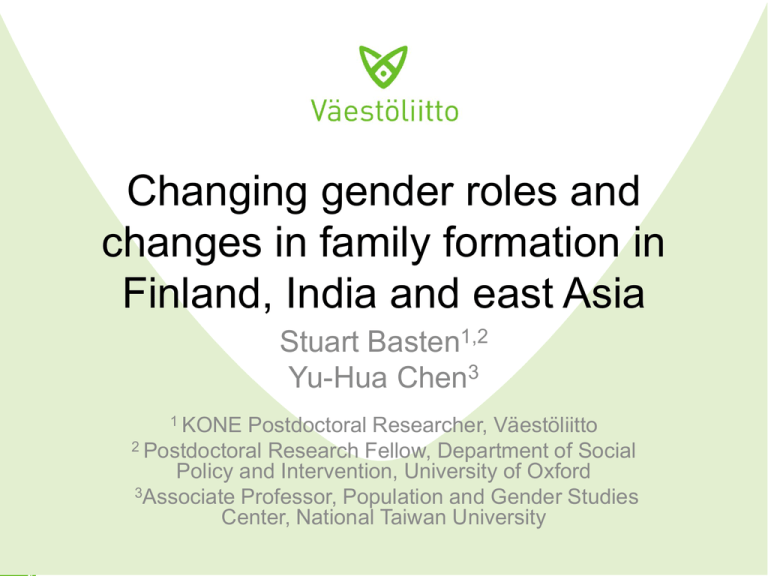
Changing gender roles and
changes in family formation in
Finland, India and east Asia
Stuart Basten1,2
Yu-Hua Chen3
1 KONE
Postdoctoral Researcher, Väestöliitto
2 Postdoctoral Research Fellow, Department of Social
Policy and Intervention, University of Oxford
3Associate Professor, Population and Gender Studies
Center, National Taiwan University
The ‘gender revolutions’
Contraceptive revolution
Educational revolution
Work revolution
Role in household
decision making
Female empowerment
Education
Access to extrahousehold economic
opportunities
Opportunity cost of
children
Desired number of
children
Knowledge of
contraception
Likelihood of
contracepting
Fertility rates
Negative relationships
• Education and
fertility
• Income and
fertility
• HDI and fertility
But an ‘incomplete’ revolution?
1. Incomplete ‘public’ revolutions
• In many settings:
– Female education poorer
– Discrimination at home and at work
– Social and cultural barriers to empowerment
– Underinvestment in female opportunities
– Women’s value lower
• Often in negative feedback with poor
economic growth and other development
issues
Consequences
• High fertility and stalled
fertility decline in many
settings
• Incursions of women’s
(reproductive) rights
and opportunities
• Violence against
women
• Sex selection bias
– Abortions, infanticide
– Squeeze on marriage
India
Source: Baochang Gu & Yong Cai. (2011). Fertility prospects in China. Expert Paper. No. 2011/14. Department of
Economic and Social Affairs. Population Division. United Nations.
2. Incomplete ‘private’ revolutions
• Even in the most developed countries,
changes in women’s domestic roles have
not caught up with changes in their public
roles
• Opportunity costs of childbearing
Education revolution
– Korea: female tertiary enrolment rose from
20% in 1975 to 81% in 2005 (Tsuya et al.
2009)
% achieved tertiary education (2009)
70
Taiwan, 2009
60
50
40
Male
Female
30
20
10
25-34
35-44
45-54
55-64
Age group
Source: Manpower Survey Statistics, DGBAS, Executive Yuan .
Participation in labour force
• New and growing opportunities
– ‘The life options of young women have widened’
(Rindfuss et al. 2004)
• Income inequality decreasing
• Highly competitive economies and
governments – high productivity and low
wages
– ‘Relatively unforgiving of the divided loyalties
inherent in the effort to combine child-raising with
working’ (Jones et al. 2009)
The ‘package’ of marital roles
•
•
•
•
Childbearing and rearing
Care for the elderly
The watchful gaze of the ‘in-laws’
Responsibility for educational success of
children
– Including extra-curricular activities and ‘cram’
schools
• Heavy household task load
• Possible co-residence with parents-in-law
Reflected in trends
8.0
7.0
6.0
TFR
5.0
4.0
3.0
2.0
1.0
0.0
Taiwan
China
China, Hong Kong SAR
Japan
Republic of Korea
India
Singapore
Thailand
Viet Nam
Japan - context
•
Source: Japan Time Use Survey 2005
A perfect storm?
• Patriarchal, patrilineal tradition
• Women expected to have very different
gendered roles in public and in private
• History of age gap between husband and
wife
• Highly educated women: opportunity costs
at breaking point
• Context for cross-border marriages?
– MEN want to get married – but just not to
Taiwanese women (and vice versa)
Men – crucial to the future
• Do we ‘downgrade’ women, or ‘update’ men?
• No question!
• The role of men in shaping the future of gender
roles and relations in Taiwan is tremendous
• An under-researched topic world wide
Population policy, fertility and
gender equity
• Question the fundamental link between
population policy and fertility
• Rather familiar assumptions on spending
on family policy and child benefit and link
to increased fertility (many studies)
• But is that the only answer?
2.00
France
NW Europe
1.80
Scandinavia
TFR
1.60
Italy and Spain
1.40
(Latvia)
1.20
(Germany)
CEE
y = 0.022x + 0.8304
R² = 0.4586
1.00
Developed East Asia
0.80
15
20
25
30
35
40
45
Time spent on domestic/childcare duties as % of women
Source: EUROSTAT Harmonised Time Use surveys, EUROSTAT fertility database,
Asia time use surveys, UN World Population Prospects 2010, Taiwan DGBAS
50
Micro-level evidence from Finland
3
2
1
0
Desired family size
4
5
Study of Finnish males at Parity 0 and 1.
Desired family size and views on gender equity
(Division of household/childcare tasks, women in
public sphere etc)
Traditional
Egalitarian
Gender equity index
Source: (Rotkirch, Basten and Mietinnen 2010)
Micro-level evidence from Finland
3
‘Househusband’
model
‘Equal sharing’
model
1
2
‘Half-and-half’
model
0
Desired family size
4
5
‘Male
breadwinner’
model
Traditional
Egalitarian
Gender equity index
Source: (Rotkirch, Basten and Mietinnen 2010)
Extrapolate up to national level?
3
Scandinavia
NW Europe
1
2
East Asia, S and E
Europe
GENDER EQUITY
MISMATCH
0
Desired family size
4
5
Yemen, Niger,
Afghanistan
Traditional
Egalitarian
Gender equity index
So what to do?
• Clearly – women’s work should be made
more compatible with childbearing
• Return to subsidy vs. reform
• Broader social change required
• Try to usher in more equal responsibilities
between women and men with respect to
childcare and housework
Finland, India and East Asia?
• Gender is a thread that runs through
partnership- and family formation in each
of these regions
– Attitudes towards gender equity among men
– Women [and men] struggling to reconcile
work and family
– Fundamental questions concerning gender
roles

